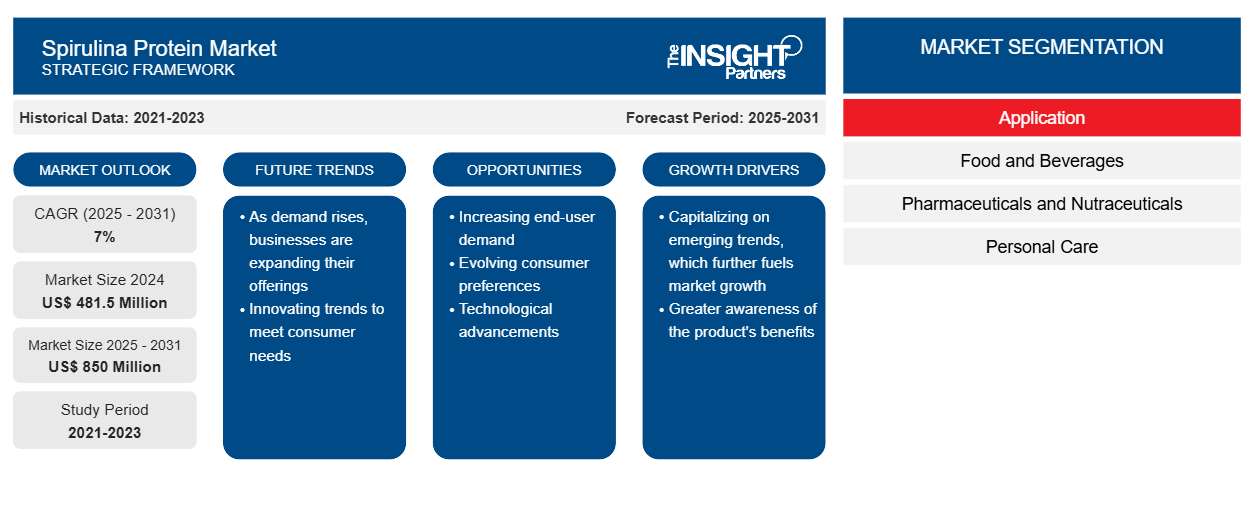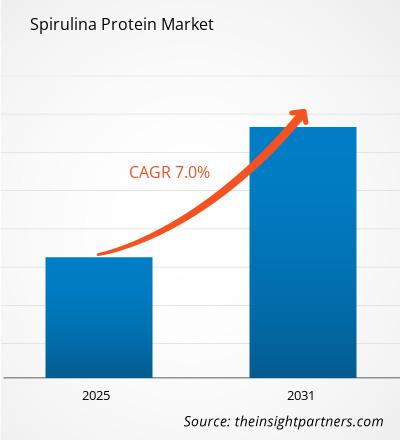The spirulina protein market size is projected to reach US$ 850 million by 2031 from US$ 450 million in 2023. The market is expected to register a CAGR of 7% in 2023–2031. Shifting consumer preferences to alternative protein sources is likely to remain key spirulina protein market trends.
Spirulina Protein Market Analysis
Over the past few years, people's awareness of environmental sustainability has increased significantly. Climate change has affected the earth's natural ecosystems and poses a significant threat to the present and future generations' well-being. Global population growth and urbanization are the primary causes of natural resource depletion, including water, fossil fuels, and land, contributing to global warming. Due to the rising global population, the demand for food is also increasing. People are heavily reliant on animal sources to meet their nutritional requirements. This factor exerts high pressure on the livestock industry. The livestock industry is one of the significant contributors to anthropogenic greenhouse gas emissions. The livestock industry is one of the major contributors to anthropogenic greenhouse gas emissions. According to the United Nations Food and Agriculture Organization (FAO), the worldwide livestock industry emits 7.1 giga tons of carbon dioxide annually, accounting for 14.5 percent of all human-caused greenhouse gas emissions. According to industry experts, livestock production emits more carbon dioxide into the atmosphere than the whole transportation industry combined. Consumers are rapidly switching to alternate protein sources due to the rising awareness regarding the negative impacts of the meat and livestock industry on the environment. Spirulina is a rich protein source and has many health benefits. Thus, the rising interest in alternative protein sources drives the spirulina protein market growth over the forecast period.
Spirulina Protein Market Overview
Spirulina is a type of blue-green algae that grows in freshwater and salt water. It contains many nutrients such as protein, thiamin, riboflavin, niacin, and minerals such as copper and iron. It is a rich source of essential amino acids, making it a popular ingredient in human nutrition. The main component of spirulina is phycocyanin, which gives it a blue color. Spirulina powder is widely used as a source of protein and amino acids in smoothies, soups, salads, herbal teas, etc. Its antioxidant and anti-inflammatory properties make it suitable for digestive and heart health. The increasing demand for spirulina due to its rich nutritional profile significantly drives the spirulina market growth. Furthermore, its skin-soothing properties drive its demand across the rapidly growing personal care industry.
Customize This Report To Suit Your Requirement
You will get customization on any report - free of charge - including parts of this report, or country-level analysis, Excel Data pack, as well as avail great offers and discounts for start-ups & universities
Spirulina Protein Market: Strategic Insights

-
Get Top Key Market Trends of this report.This FREE sample will include data analysis, ranging from market trends to estimates and forecasts.
Spirulina Protein Market Drivers and Opportunities
Rising Awareness of Health Benefits of Spirulina Protein to Favor Market
The rising awareness of the health benefits of spirulina is driving the global spirulina market. There is an increasing awareness of the environmental impacts of animal-derived protein across the globe. The livestock industry has significant carbon emissions and is also responsible for animal cruelty. People are taking steps to minimize the environmental impacts of the livestock industry and are seeking alternatives to animal protein. Microalgae, including spirulina, are among the richest non-animal protein sources and are generally marketed as superfoods due to their high bioactive content. The rising demand for sustainable protein sources is driving the growth of the spirulina protein market. Spirulina protein is widely available in powder form and is extensively used in dietary supplements due to its high nutritional value. Spirulina powder is used to make tablets, capsules, and gummies and is consumed in powder format. It is generally used as a functional ingredient in smoothies, salads, soups, stocks, snacks, and baked goods. Spirulina protein powder is used in personal care products as an anti-aging, brightening, and anti-acne agent. It has gained immense popularity in the skincare routines of celebrities. The rising demand for spirulina protein across various application areas significantly propels the spirulina market growth.
Altering Consumer Preferences and Adoption of Sustainable Non-Animal Proteins to Provide Massive Growth Opportunities
The preferences of consumers are changing due to increased health awareness, especially after the COVID-19 outbreak. The pandemic altered global consumer preferences as health became the top priority. The focus on immune health increased dramatically, which is expected to provide lucrative opportunities for immune-boosting ingredients such as spirulina. Also, as sustainability became one of the top priorities in the wake of the pandemic, people started consuming sustainable proteins and reduced animal-derived protein consumption. This factor created significant growth opportunities for the spirulina protein market.
Spirulina Protein Market Report Segmentation Analysis
Key segments that contributed to the derivation of the Spirulina Protein Market analysis are application and geography.
- Based on application, the spirulina protein market is divided into food and beverages, pharmaceuticals and nutraceuticals, personal care, and others. The pharmaceuticals and nutraceuticals segment held a larger market share in 2023. Spirulina is a powerful antioxidant and has anti-inflammatory properties. Due to its low cholesterol levels, it boosts heart health and reduces the risk of cardiovascular diseases. It also has prebiotic properties, which support gut health and reduce digestion problems. Spirulina is a rich protein source, which helps increase muscle strength. The rising awareness of the health benefits of spirulina is driving its demand in the pharmaceuticals and nutraceuticals industry. Spirulina is available in powder, tablets, capsules, and gummies. The rising health concerns due to hectic lifestyles and lack of physical activity drive the demand for nutraceuticals supporting overall immune health. This factor can also boost the growth of the spirulina market across the pharmaceuticals and nutraceuticals space.
Spirulina Protein Market Share Analysis by Geography
The geographic scope of the Spirulina Protein Market report is mainly divided into five regions: North America, Asia Pacific, Europe, Middle East & Africa, and South America/South & Central America. The Asia Pacific spirulina protein market held the largest market share in 2023. Asia Pacific is one of the significantly growing markets for spirulina protein owing to the presence of a potential customer base, low manufacturing costs, cheap skilled labor, and rising demand for sustainable protein sources. Moreover, the region's rapidly growing personal care industry also provides significant growth potential to the spirulina protein market, as spirulina has a wide range of applications in personal care products. Spirulina possesses anti-aging, anti-acne, and soothing properties, which have many benefits in daily skincare. Further, the rising demand for functional food and beverages with high protein content and low environmental impact drives the spirulina protein market across Asia Pacific.
Spirulina Protein Market Regional Insights
The regional trends and factors influencing the Spirulina Protein Market throughout the forecast period have been thoroughly explained by the analysts at The Insight Partners. This section also discusses Spirulina Protein Market segments and geography across North America, Europe, Asia Pacific, Middle East and Africa, and South and Central America.
Spirulina Protein Market Report Scope
| Report Attribute | Details |
|---|---|
| Market size in 2024 | US$ 481.5 Million |
| Market Size by 2031 | US$ 850 Million |
| Global CAGR (2025 - 2031) | 7% |
| Historical Data | 2021-2023 |
| Forecast period | 2025-2031 |
| Segments Covered |
By Application
|
| Regions and Countries Covered |
North America
|
| Market leaders and key company profiles |
|
Spirulina Protein Market Players Density: Understanding Its Impact on Business Dynamics
The Spirulina Protein Market is growing rapidly, driven by increasing end-user demand due to factors such as evolving consumer preferences, technological advancements, and greater awareness of the product's benefits. As demand rises, businesses are expanding their offerings, innovating to meet consumer needs, and capitalizing on emerging trends, which further fuels market growth.

- Get the Spirulina Protein Market top key players overview
Spirulina Protein Market News and Recent Developments
The Spirulina Protein Market is evaluated by gathering qualitative and quantitative data post primary and secondary research, which includes important corporate publications, association data, and databases. The following is a list of developments in the market for speech and language disorders and strategies:
- GNT launched a range of green EXBERRY powder made from spirulina and turmeric. (Source: GNT, Press Release/Company Website/Newsletter, 2022)
- Prolgae Spirulina Supplies, an organic spirulina manufacturer, launched a sweet spirulina powder and spirulina protein bar. (Source: Prolgae Spirulina Supplies, Press Release/Company Website/Newsletter, 2021)
Spirulina Protein Market Report Coverage and Deliverables
The “Spirulina Protein Market Size and Forecast (2021–2031)” report provides a detailed analysis of the market covering below areas:
- Market size and forecast at global, regional, and country levels for all the key market segments covered under the scope
- Market dynamics such as drivers, restraints, and key opportunities
- Key future trends
- Detailed PEST/Porter’s Five Forces and SWOT analysis
- Global and regional market analysis covering key market trends, major players, regulations, and recent market developments
- Industry landscape and competition analysis covering market concentration, heat map analysis, prominent players, and recent developments
- Detailed company profiles
- Historical Analysis (2 Years), Base Year, Forecast (7 Years) with CAGR
- PEST and SWOT Analysis
- Market Size Value / Volume - Global, Regional, Country
- Industry and Competitive Landscape
- Excel Dataset
Recent Reports
Testimonials
Reason to Buy
- Informed Decision-Making
- Understanding Market Dynamics
- Competitive Analysis
- Identifying Emerging Markets
- Customer Insights
- Market Forecasts
- Risk Mitigation
- Boosting Operational Efficiency
- Strategic Planning
- Investment Justification
- Tracking Industry Innovations
- Aligning with Regulatory Trends





















 Get Free Sample For
Get Free Sample For